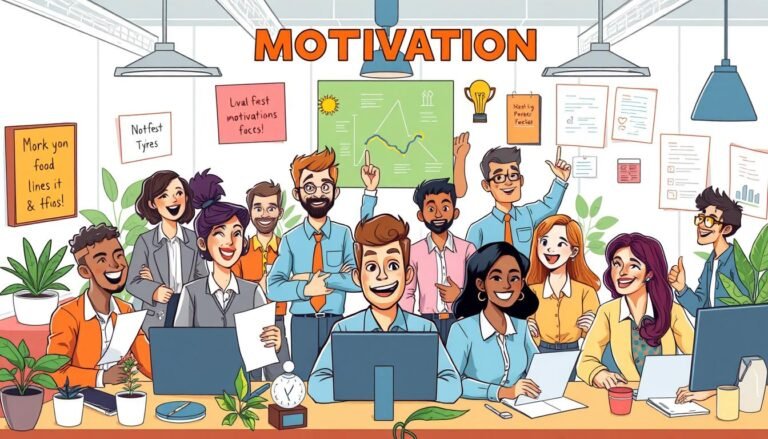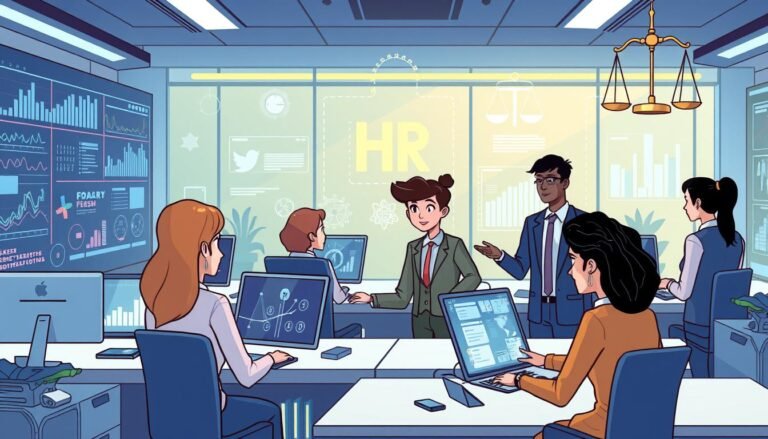Future-Proofing HR Capabilities
The world of Human Resources is changing fast. As we look towards 2024, HR departments face new challenges in managing talent. Strategic workforce planning has become crucial for success. Companies are embracing HR technology adoption to stay ahead. Digital transformation is reshaping how we work and interact.
Recent studies show the impact of these changes. Sage People found that 87% of top executives credit HR for speeding up change during COVID-19. But there’s a catch – 52% of leaders think these HR changes won’t last. This gap highlights the need for long-term HR strategies.
The future of work demands new skills. The OECD predicts over 1 billion people will need retraining by 2030. HR must lead this charge. They’re developing T-shaped professionals with both deep expertise and broad soft skills. This approach helps tackle complex workplace challenges.
Data is power in modern HR. Analytics tools now drive decisions on hiring, performance, and engagement. They offer insights that shape company culture and boost productivity. As we move forward, HR’s role in guiding organizations through change will only grow.
Key Takeaways
- HR departments are crucial for organizational change
- Strategic workforce planning is essential for future success
- HR technology adoption is transforming talent management
- Data-driven HR decisions are becoming the norm
- Developing T-shaped HR professionals is a priority
- Continuous learning is necessary to address skills gaps
- HR analytics tools provide valuable workforce insights
Understanding the Need for Future-Proofing HR
The world of HR is changing fast. New tech and shifts in the workforce are key drivers. To keep up, companies need to update their HR plans for the future.
The Evolving Landscape of HR
HR roles are changing. They’re moving from just handling paperwork to being key players in shaping company culture. This shift is important because 45% of workers say they’re feeling more stressed at work lately.
Key Drivers of Change in HR Practices
Several things are changing how HR works:
- Talent shortage: The UK might face a shortage of 2.5 million skilled workers by 2030.
- Remote work: New ways of working require fresh HR strategies.
- Employee well-being: Programs aimed at improving well-being can boost productivity and cut down on absences.
- Learning and development: Companies spend about $1,220 per employee each year on training.
The Role of Technology in HR Transformation
Technology is changing HR:
- Talent Analytics: Help make decisions with data.
- Agile HR Processes: Make tasks like screening resumes and setting up interviews easier.
- HRIS software: Makes HR work smoother and helps teams talk better.
By embracing these changes and using smart strategies, HR teams can prepare for the future. This will help companies succeed.
Assessing Current HR Capabilities
To make HR departments future-proof, organizations need to check their current abilities. They must find ways to get better. This means looking at what they do well, what they don’t, and comparing themselves to others in the field.
Identifying Strengths and Weaknesses
It’s vital to know what HR does well and what it needs to work on. Only 11% of companies are really good at planning for their workforce. This shows HR needs to know its strengths and fix its weaknesses.
Benchmarking Against Industry Standards
It’s important to compare HR practices to what others in the industry do. For example, in 2022, 58% of U.S. workers got to work from home sometimes. Companies that focus on diversity and inclusion make better hiring choices. These comparisons help HR teams keep up with the latest trends.
Gathering Employee Feedback for Insights
Listening to what employees say is a treasure trove of information for HR. By using data and feedback, HR can understand how the workforce is doing. Sadly, 78% of reasons people leave could be fixed if caught early. This shows how crucial it is to listen and act on feedback.
By focusing on these areas, HR can create a plan for the future. This includes training employees and making decisions based on data. Investing in HR technology and encouraging learning are steps towards a workforce ready for the future.
Embracing Technology in HR Strategies
HR departments are in the middle of a digital change. New technology is changing how HR works. It brings in tools and data analytics to make HR better and more efficient.
Innovative HR Tools and Software
More HR leaders are using new technology. 45% of them are focusing on it. These tools make HR work smoother and improve how employees feel.
AI chatbots are now helping with first interviews. This saves a lot of time and money.
The Importance of Data Analytics in HR
Data is changing HR for the better. It helps find the best workers and where to get better. This has made 15% more employees meet their goals.
It has also made employees 20% happier. This is thanks to using modern HR methods.
Automating HR Processes for Enhanced Efficiency
HR is getting more digital. This means HR can do more important work. Automated systems have cut down the time it takes to hire by 25%.
Technology has also made employees 30% more engaged. This is thanks to better feedback systems.
| HR Tech Impact | Percentage |
|---|---|
| HR Leaders Prioritizing New Tech | 45% |
| Teams Created for AI | 36% |
| Increase in Performance Goal Achievement | 15% |
| Reduction in Time-to-Fill Positions | 25% |
| Rise in Employee Engagement | 30% |
The future of HR is all about technology. By using these new tools, HR can help the company succeed and make work better for everyone.
Developing a Flexible HR Workforce
The modern workplace is changing fast. HR professionals need to keep up. Strategic workforce planning is key in this fast-paced world. Let’s see how HR teams can become more flexible and resilient.
Strategies for Upskilling Employees
Upskilling and reskilling are vital for staying ahead. HR teams can start by offering training in digital skills, data analysis, and soft skills. This helps them support the whole organization better.
The Benefits of a Diverse Talent Pool
A diverse team brings new ideas and solutions. HR can promote this by hiring inclusively and setting up mentorship programs. This diversity helps the company adapt and serve a global market.
Fostering a Culture of Continuous Learning
Building a culture of learning is crucial for success. HR can lead by:
- Hosting regular skill-building workshops
- Supporting cross-departmental projects
- Offering access to online learning platforms
| Skill Area | Importance | Learning Methods |
|---|---|---|
| Digital Literacy | High | Online courses, workshops |
| Data Analysis | Critical | Hands-on projects, certifications |
| Soft Skills | Essential | Role-playing, mentoring |
By focusing on these skills, HR can build a flexible workforce. This not only helps employees grow but also boosts the company’s success in a changing world.
Enhancing Employee Experience and Engagement
Employee Experience is key to a company’s success. Focusing on this area leads to higher profits and happier employees. Let’s look at ways to boost engagement and make the workplace better.
Understanding Employee Needs and Expectations
It’s important to know and meet employee needs. A lack of appreciation can make 79% of employees want to leave. Showing appreciation boosts motivation and keeps employees around longer.
Creating a Positive Work Environment
A good workplace encourages productivity and creativity. Companies that focus on Employee Experience grow faster and make more money. They also have employees who are more likely to recommend their workplace.
Implementing Effective Communication Channels
Good communication is crucial for Agile HR Processes. It helps share company values, celebrate achievements, and get feedback. This supports a culture of growth and keeps employees happy.
| Metric | Impact |
|---|---|
| Engaged Teams | 23% more profitable |
| Employee Recognition | 69% work harder when efforts are recognized |
| EX Investment | 25% greater profitability |
| Innovation | 51% revenue from new products (top quartile) |
By focusing on these areas, companies can create a great workplace. This benefits both employees and the company’s success. Remember, a positive Employee Experience is essential for business success.
Building a Strong Employer Brand
A strong employer brand is crucial for attracting top talent in today’s job market. Companies that focus on this area see great results in their Strategic Workforce Planning.
Attracting Top Talent
Strong employer branding brings big benefits. Companies with strong brands get up to 50% more job applications. This means they can pick the best talent, which is key for Strategic Workforce Planning.
Promoting Company Values and Culture
It’s important to show off your company values. 69% of employees want to work for a brand they’re proud of. This makes them more engaged and likely to stay.
Talent Analytics show that firms with strong employer brands have a 28% lower turnover rate.
Leveraging Social Media for Employer Branding
Social media is a great tool for employer branding. It lets companies show off their culture and connect with potential hires. Targeted campaigns can get impressive results.
For example, an email campaign for African American Women in Tech got a 49% open rate.
| Employer Branding Impact | Percentage |
|---|---|
| Job seekers considering employer brand before applying | 75% |
| Candidates viewing company reputation as critical | 95% |
| Reduction in cost per hire with strong branding | 50% |
Investing in employer branding is a smart move. It boosts employee satisfaction, performance, and engagement. It’s a key part of modern HR practices.
Implementing Agile HR Practices
The move from old to new HR ways is a big step in digital change. Companies making this shift can better meet changing needs.
The Shift from Traditional to Agile HR
Agile HR changes old ways by supporting flexible career paths and learning on demand. HR teams work in short cycles, 2-4 weeks, to quickly solve problems and improve them later. This leads to quicker development and more innovation.
Responding Quickly to Organizational Changes
Companies using Agile HR do better financially, often in the top 25%. They can quickly change plans when needed. For example, Agile has cut new hire onboarding from 10 days to just three in some places.
Encouraging Cross-Functional Collaboration
Agile HR supports teams with many skills. HR works with others to manage people better. Teams like this are 33% more efficient and productive than old structures.
- 94% of companies using Agile practices report improved innovation pace
- 83% see higher customer satisfaction
- 81% experience better employee engagement
Agile HR focuses on results and being flexible. It helps companies show how they improve over time. This fits well with today’s fast-changing work world.
Measuring Success in HR Initiatives
HR success comes from using data and talent analytics. It’s important to set clear goals to track progress and find areas to get better. Let’s look at how to measure HR success well.
Setting Clear KPIs for HR Outcomes
Choosing the right KPIs is key to judging HR efforts. Some important metrics include:
- Employee Net Promoter Score (eNPS): A score between 10-30 is good, over 30 is excellent.
- Engagement Rate: Aim for 50% or higher.
- Employee Turnover Rate: Varies by industry, but lower is generally better.
- Employee Retention Rate: Calculate by dividing retained employees by total employees over a set period.
- Absenteeism Rate: A healthy rate is around 1.5%.
Utilizing Employee Surveys for Performance Tracking
Regular surveys give insights into how happy and engaged employees are. They help see how HR efforts are doing and what needs work. Tools for talent analytics can help understand and use this data.
Continuous Improvement Through Feedback Loops
Feedback loops help HR make better decisions and tweak strategies as needed. This keeps HR practices in line with company goals and what employees need.
| Skill | Importance | Expected by 2025 |
|---|---|---|
| Data Analysis | Crucial | High |
| Change Management | Necessary | Essential |
| Cultural Competence | Crucial | Vital |
| Leadership | Necessary | Essential |
By focusing on these skills, HR can make sure they’re ready to measure and improve their work in the future.
The Future of HR: Trends and Predictions
Looking ahead, making HR future-proof is key in today’s fast-changing business world. The human resources field is changing a lot. This is because of new technology and shifts in the workforce.
Anticipating Changes in Workforce Dynamics
HR teams are now more than just back-office workers. They are becoming key players in the business. This change is thanks to the rise of people analytics in making HR decisions.
Companies that use analytics well can attract and keep the best employees. They can predict who will succeed and who might leave.
The Rise of Remote Work and Its Impact on HR
Remote work is set to grow even more in the next decade. It’s changing how HR works. Now, keeping employees happy and healthy is a top priority.
HR needs to find new ways to support and connect with workers who are not in the office.
Preparing for AI and Automation in HR Functions
Digital changes are making HR better. AI and automation are making HR tasks easier and smarter. At the same time, the need for soft skills is growing.
HR needs to keep up with technology to stay ahead. This includes using new ways to check if candidates have the right soft skills.
Source Links
- The One Thing You Need For Future-Proofing Your HR Department
- Future-Proofing HR: Embracing Technology and Data for HR Success – Omni HR
- 7 Online Strategies to Future-Proof Your HR Workforce
- 4 top tips for future-proofing your HR strategy: Staying ahead in a rapidly changing world
- Strategic Workforce Planning: Navigating the Future of HR
- Developing a future-proof HR strategy to align with trends
- Human Resource Planning: Future-Proofing your Workforce
- The Future of HR: Embracing Technology and Automation
- Future-proofing HR: Technological disruptions in human resource management – ETHRWorld
- Future-Proofing HR: Leveraging AI for Strategic Workforce Management
- Building a flexible, Future-Proof workforce – HR Future
- "Future-Proofing HR: 10 Trends Reshaping Work in 2024"
- 7 Future-Proofing HR Trends: Navigate Workplace Strategies
- Enhancing Employee Experience: A Strategic Imperative for Modern Workplaces
- Employee Experience: A Complete Guide for HR
- How To Develop an Employer Branding Strategy in 14 Steps
- The Strategic Imperative for Building an Employer Branding Business Case
- Agile HR: All You Need to Know to Get Started
- Agile HR Practices and Future of Work
- How to Measure HR Effectiveness: 12 Useful Metrics
- Future – proofing your HR Skills: "Top 20 must – haves for 2025"
- The Future of HR: Predictions for the Next Decade
- The Future of HR: Predictions and Trends for the Next Decade








